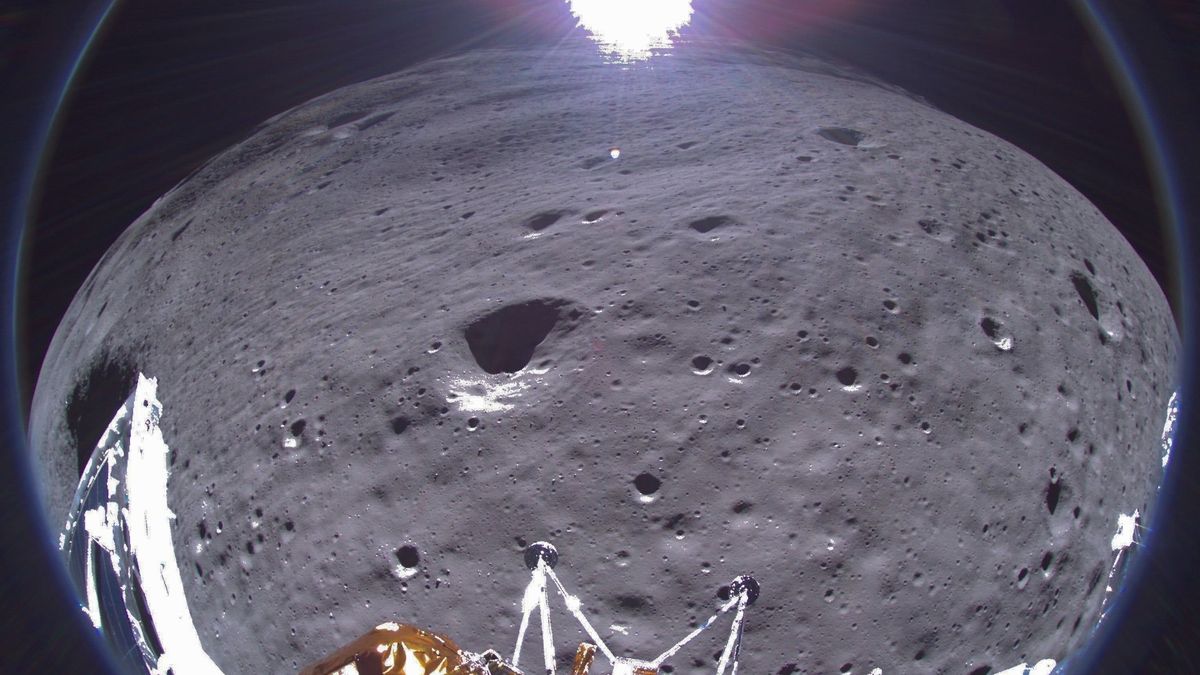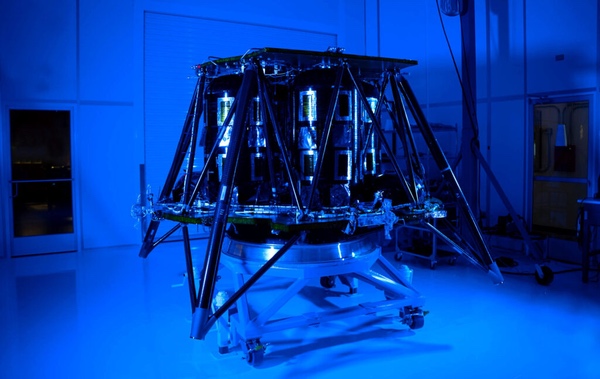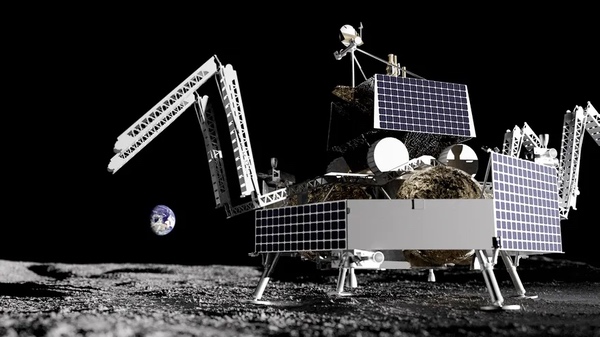The US Moon Lander, named Odysseus, became the first private spaceship on the moon. It was launched by Intuitive Machines and landed near Malapert A crater in a wonky angle due to problems with its laser rangefinders that caused it to tip over onto its side but still functioned in that state. Despite this setback, Odysseus completed several tests and sent back photos before entering a weekslong lunar night. NASA got data back from all five of its active payloads after the historic touchdown, including NASA experiments put on board via a $118 million contract from its Commercial Lunar Payload Services program (CLPS). The company acknowledged that there were several issues with the lander including problems with its guidance system, communication systems and power management. Intuitive Machines sees Odie's landing as the first of many pulled off by private spacecraft in the coming years and hopes to launch its second mission later this year.
Intuitive Machines' Odysseus: The First Private Moon Lander Successfully Launches and Completes Tests on the Moon Despite Technical Issues
Intuitive Machines sees Odie's landing as the first of many pulled off by private spacecraft in the coming years and hopes to launch its second mission later this year.
It was launched by Intuitive Machines and landed near Malapert A crater in a wonky angle due to problems with its laser rangefinders that caused it to tip over onto its side but still functioned in that state. Despite this setback, Odysseus completed several tests and sent back photos before entering a weekslong lunar night.
NASA got data back from all five of its active payloads after the historic touchdown, including NASA experiments put on board via a $118 million contract from its Commercial Lunar Payload Services program (CLPS).
The US Moon Lander, named Odysseus, became the first private spaceship on the moon.





- #CommercialSpaceFlight
- FirstPrivateSpaceshipOnTheMoon
- #IntuitiveMachines
- #PrivateMoonLander #Odysseus #NASA
Confidence
80%
Doubts
- The laser rangefinders that caused the wonky angle may have been faulty or not calibrated properly.
- There is no information on how long it took for Odysseus to function in its tilted state, and if this affected any of the tests conducted.
Sources
76%
US Moon Lander 'Permanently' Asleep After Historic Landing
Newsmax Media Inc. Sunday, 24 March 2024 20:51Unique Points
- The uncrewed American lander named Odysseus became the first private spaceship on the moon.
- Odie broke one or more of its six landing legs during the touchdown due to a problem with its laser rangefinders and tipped over onto its side but still functioned in that state.
- NASA got data back from all five of its active payloads after the historic touchdown, including NASA experiments put on board via a $118 million contract from its Commercial Lunar Payload Services program (CLPS).
- Despite a hard landing that caused the spacecraft to fall almost on its side, IM-1 was able to operate most of the spacecraft's payloads from NASA and commercial customers.
- The company acknowledged that there were several issues with the lander including problems with its guidance system, communication systems and power management.
Accuracy
- The mission was hailed as a success by Intuitive Machines and NASA, even though it ran into multiple problems along the way including tipping over at landing.
Deception (30%)
The article is deceptive in several ways. Firstly, the author claims that Odysseus had not phoned home this week when its solar panels were projected to receive enough sunlight to turn on its radio. However, it was actually due to a technical issue with NASA's Deep Space Communications Complex (DSCC) which caused communication failure for all spacecraft in the vicinity of Earth including Odysseus.- The author states that after several days of waiting, operators had confirmed that the power system of the lander would not complete another call home. However, this is incorrect as NASA's DSCC was responsible for the communication failure and there were no technical issues with Odysseus.
- The author claims that Odysseus had not phoned home this week when its solar panels were projected to receive enough sunlight to turn on its radio. However, it was actually due to a technical issue with NASA's Deep Space Communications Complex (DSCC) which caused communication failure for all spacecraft in the vicinity of Earth including Odysseus.
Fallacies (85%)
The article contains several fallacies. The first is an appeal to authority when it states that NASA has hailed the mission as a success despite multiple problems along the way. This statement implies that because NASA said it was successful, it must be true without providing any evidence or reasoning for this claim.- NASA has hailed the mission as a success
- The United States, along with international partners, wants to eventually develop long-term habitats in the region
Bias (85%)
The article contains a mix of religious and monetary bias. The author uses language that dehumanizes the lander by referring to it as 'Odie', which is not an appropriate way to refer to inanimate objects. Additionally, the use of phrases such as 'cementing its legacy into history' implies that Odysseus has a soul or consciousness, which is not true. The author also uses language that demonizes NASA by implying that they are responsible for the lander's failure and suggesting that their plans to return astronauts to the moon later this decade will be unsuccessful.- intuitive Machines had hoped that it might 'wake up' once it received sunlight again
- NASA is planning to return astronauts to the moon later this decade.
- The lander touched down at a wonky angle on Feb. 22, but was still able to complete several tests and send back photos before its mission was determined to have ended a week later
Site Conflicts Of Interest (100%)
None Found At Time Of Publication
Author Conflicts Of Interest (0%)
None Found At Time Of Publication
65%
Intuitive Machines' historic private moon mission comes to an end
Space.com Mike Wall Monday, 25 March 2024 18:00Unique Points
- Intuitive Machines' Odysseus spacecraft landed on the moon near Malapert A, a crater about 190 miles (300 kilometers) from the moon's south pole on Feb. 22, 2024.
- Odie broke one or more of its six landing legs during the touchdown due to a problem with its laser rangefinders and tipped over onto its side but still functioned in that state.
- NASA got data back from all five of its active payloads after the historic touchdown, including NASA experiments put on board via a $118 million contract from its Commercial Lunar Payload Services program (CLPS).
- Intuitive Machines sees Odie's landing as the first of many pulled off by private spacecraft in the coming years and hopes to launch its second mission later this year.
- Astrobotic also got a CLPS deal. Its next mission will use a bigger lander called Griffin to put NASA's ice-hunting VIPER rover down near the lunar south pole.
Accuracy
- The mission was hailed as a success by Intuitive Machines and NASA, even though it ran into multiple problems along the way including tipping over at landing.
- Despite a hard landing that caused the spacecraft to fall almost on its side, IM-1 was able to operate most of the spacecraft's payloads from NASA and commercial customers.
Deception (50%)
The article is deceptive in several ways. Firstly, the title of the article claims that Intuitive Machines' historic private moon mission has come to an end when it hasn't. The company announced on March 23rd that Odie will not wake up and its power system would not complete another call home.- The title of the article claims that Intuitive Machines' historic private moon mission has come to an end when it hasn't.
Fallacies (85%)
The article contains an appeal to authority by stating that NASA and Intuitive Machines see Odie's landing as the first of many pulled off by private spacecraft in the coming years. Additionally, there is a dichotomous depiction of Odie's mission success when it was initially stated that it would go silent after sunset but then later reported that its eyes will remain closed for good.- The first successful private moon-landing mission is officially over.
Bias (85%)
The article is reporting on the end of a private moon mission by Intuitive Machines. The author mentions that Odie, the spacecraft that landed on the moon, was expected to operate for seven Earth days but went silent after sunset at its landing site. However, it's not clear if this was due to technical issues or because it ran out of power as predicted by Intuitive Machines. The author also mentions that Odie broke one or more of its six landing legs during the touchdown and tipped over onto its side but still functioned in its supine state. This suggests a level of resilience, which could be seen as positive bias.- Odie broke one or more of its six landing legs during the touchdown and tipped over onto its side but still functioned in its supine state.
- The solar-powered Odie operated on the lunar surface for seven Earth days
Site Conflicts Of Interest (50%)
None Found At Time Of Publication
Author Conflicts Of Interest (0%)
None Found At Time Of Publication
62%
Unique Points
- The IM-1 lunar lander mission officially ended on February 29, nearly a week after landing.
- Flight controllers at Intuitive Machines put the lander into a mode so that it could wake up and start transmitting when sunlight returned to the lander in a few weeks.
- The company started listening for any transmissions on Wednesday, when by its calculations the landers panels should be illuminated again, generating power to operate its transmitter.
- Crain said he was confident that had those laser rangefinders been working they would have nailed the landing.
- Trent Martin, senior vice president of space systems at Intuitive Machines acknowledged it was a long shot but started listening for any transmissions on Wednesday.
- The company concluded Saturday that Odie's power system would not complete another call home and confirmed that Odie has permanently faded after cementing its legacy into history as the first commercial lunar lander to land on the Moon.
- Both IM-1 and Astrobotic's Peregrine missions are now complete, both companies are taking stock of what they achieved and where they fell short as they plan their next missions.
- Despite a hard landing that caused the spacecraft to fall almost on its side, IM-1 was able to operate most of the spacecraft's payloads from NASA and commercial customers.
- In late February, Intuitive Machines held a briefing where it discussed what went wrong with Odie's mission.
- The company acknowledged that there were several issues with the lander including problems with its guidance system, communication systems and power management.
Accuracy
No Contradictions at Time Of Publication
Deception (30%)
The article is deceptive in several ways. Firstly, the author claims that the IM-1 lunar lander mission officially came to an end on February 29th when it was put into a mode so that it could wake up and start transmitting if it survived bitterly cold conditions. However, this information is not accurate as there are no details about what happened after the spacecraft hit the surface faster than it was designed to. Secondly, the author quotes Trent Martin saying that they will listen for any transmissions on Wednesday when by their calculations, the landers panels should be illuminated again generating power to operate its transmitter. However, this information is not accurate as there are no details about what happened after Wednesday and whether or not they were able to hear anything from the spacecraft. Lastly, the author claims that Odie's power system would not complete another call home which confirms that it has permanently faded into history but does not provide any evidence of this claim.- The article quotes Trent Martin saying that they will listen for any transmissions on Wednesday when by their calculations, the landers panels should be illuminated again generating power to operate its transmitter. However, this information is not accurate as there are no details about what happened after Wednesday and whether or not they were able to hear anything from the spacecraft.
- The article claims that Odie's power system would not complete another call home which confirms that it has permanently faded into history but does not provide any evidence of this claim.
- The article states that the IM-1 lunar lander mission officially came to an end on February 29th when it was put into a mode so that, when sunlight returned to the lander in a few weeks, it could wake up and start transmitting. However, this information is not accurate as there are no details about what happened after the spacecraft hit the surface faster than it was designed to.
Fallacies (70%)
The article contains several fallacies. The author uses an appeal to authority when they quote Trent Martin as saying that it is unlikely the spacecraft will revive. This statement implies that Martin's opinion should be taken as fact without any evidence or reasoning provided to support his claim.- > Crain said he was confident that, had those laser rangefinders been working,
Bias (75%)
The article contains a few examples of bias. Firstly, the author uses language that dehumanizes and demonizes one side as extreme or unreasonable by referring to white supremacists celebrating the reference to racist conspiracy theories in an X account's tweet. Secondly, there is a disproportionate number of quotes from far-right influencers on Telegram compared to other sources, which could be seen as reflecting a specific position. Lastly, the author uses language that implies one side has been dog-whistling and promoting extremism by referring to Vivek Ramaswamy's support for QAnon.- GOP presidential candidate Vivek Ramaswamy has been dog-whistling to supporters of extremist far-right ideologies and wild conspiracy theories like QAnon
- verified accounts on X and major far-right influencers on platforms like Telegram were celebrating.
- white supremacists online celebrated the reference to racist conspiracy theories
Site Conflicts Of Interest (50%)
None Found At Time Of Publication
Author Conflicts Of Interest (0%)
None Found At Time Of Publication
63%
Houston-made moon lander did not reawaken from the cold lunar night
Houston Chronicle Andrea Leinfelder Monday, 25 March 2024 18:52Unique Points
- ,
- The uncrewed American lander named Odysseus became the first private spaceship on the moon.
- Odies carried a suite of NASA instruments designed to improve scientific understanding of the lunar south pole.
- Intuitive Machines sees Odie's landing as the first of many pulled off by private spacecraft in the coming years and hopes to launch its second mission later this year.
Accuracy
- The mission was hailed as a success by Intuitive Machines and NASA, even though it ran into multiple problems along the way including tipping over at landing.
- Odysseus carried a suite of NASA instruments designed to improve scientific understanding of the lunar south pole.
Deception (50%)
None Found At Time Of Publication
Fallacies (100%)
None Found At Time Of Publication
Bias (85%)
The author uses language that dehumanizes the lander by referring to it as 'Odie' and saying that its systems have permanently faded. The author also quotes a statement from Intuitive Machines which says Odysseus has permanently faded after cementing its legacy into history, implying that this is a negative thing.- The lander was supposed to call home if its systems outperformed manufacturers' expectations.
- This confirms that Odie has permanently faded after cementing its legacy into history as the first commercial lunar lander to land on the Moon.
Site Conflicts Of Interest (0%)
The author has multiple conflicts of interest on the topics provided. The article discusses Intuitive Machines and their Houston-made moon lander, which is a commercial space sector company with ties to NASA's human spaceflight robotic exploration and operations in low Earth orbit. Additionally, Elon Musk's Texas footprint is also mentioned as part of the commercial space sector.- The article discusses Intuitive Machines and their Houston-made moon lander, which is a commercial space sector company with ties to NASA's human spaceflight robotic exploration and operations in low Earth orbit.
Author Conflicts Of Interest (0%)
None Found At Time Of Publication